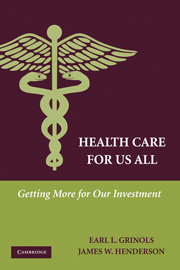Book contents
- Frontmatter
- Contents
- List of Tables
- List of Figures
- Preface
- Acknowledgments
- Executive Summary of the Targeted Intervention Plan
- PART I GOALS AND WORKING PRINCIPLES
- PART II BACKGROUND ECONOMICS AND ETHICS
- PART III APPLICATION
- PART IV PROTECTIVE MEASURES
- 9 Forestalling Free Riders
- 10 Preserving Prices
- 11 Inducing Innovation
- 12 Summary
- A Top Ten Goals for the American Health Care System
- B Badly Done Insurance Programs Can be Worse Than No Insurance
- C Incentive Symmetry and Intervention Principle
- D Plan Workability
- E Market Power Response to Insurance
- Glossary and Definitions
- References
- Index
11 - Inducing Innovation
Published online by Cambridge University Press: 05 June 2012
- Frontmatter
- Contents
- List of Tables
- List of Figures
- Preface
- Acknowledgments
- Executive Summary of the Targeted Intervention Plan
- PART I GOALS AND WORKING PRINCIPLES
- PART II BACKGROUND ECONOMICS AND ETHICS
- PART III APPLICATION
- PART IV PROTECTIVE MEASURES
- 9 Forestalling Free Riders
- 10 Preserving Prices
- 11 Inducing Innovation
- 12 Summary
- A Top Ten Goals for the American Health Care System
- B Badly Done Insurance Programs Can be Worse Than No Insurance
- C Incentive Symmetry and Intervention Principle
- D Plan Workability
- E Market Power Response to Insurance
- Glossary and Definitions
- References
- Index
Summary
If we continue on our current path of trying harder and harder to shift the costs of developing new medicines to someone else, rather than paying our fair share, everyone's effort to get a free ride on new drugs will grind the development of new drugs to a halt.
Mark McClellan, Center for Medicare and Medicaid Services Commissioner, 2003Summary: Monopolies whose buyers pay fraction c of the product cost respond by raising their price for the initial quantity q0 from p0 to p0 and adjust to a different price and quantity only if profits are thereby raised further. A prescription plan that includes a 20 percent co-payment provision thus magnifies the drug patent holder's profits more than a fivefold increase in price at the original output would.
Pharmaceutical patents are anachronistic holdovers from an era in which modern economic understanding and tax tools were unavailable. Superior mechanisms lie somewhere between a first-best pricing solution for the entire economy at one extreme and the current arrangements at the other. We discuss the economics of suggested alternatives and suggest that the intertemporal bounty is the best way to meet the multiple objectives of immediate distribution at marginal cost pricing of recently-innovated patented drugs and easily administered efficient inducement to continued innovation. The intertemporal bounty prevents the expansion of monopoly power resulting from co-pay or co-insurance provisions common to modern prescription drug plans.
Introduction
The pharmaceutical industry is characterized by large sunk costs, high fixed costs, low variable costs, segmentable markets (where sellers can distinguish consumer types and charge different prices), and strong patent protection for drug discoveries.
- Type
- Chapter
- Information
- Health Care for Us AllGetting More for Our Investment, pp. 193 - 205Publisher: Cambridge University PressPrint publication year: 2009



